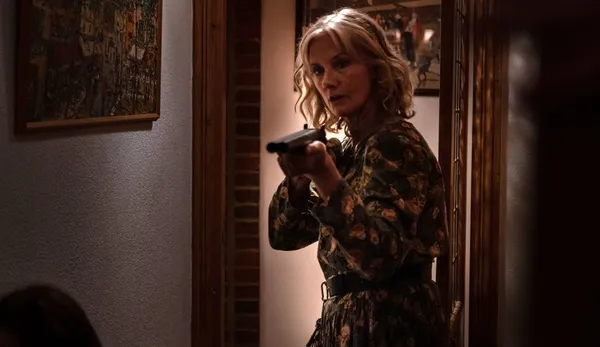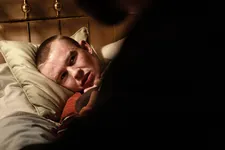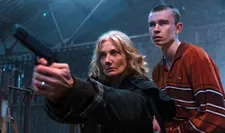 |
| Joely Richardson in Little Bone Lodge Photo: Signature Entertainment |
Making its début as part of the Frightfest strand at this year’s Glasgow Film Festival and now available on digital platforms, Little Bone Lodge is a small scale thriller which makes a very big impression. Writer Neil Linpow plays Jack, a criminal on the run with his childlike but unpredictably violent young brother, Matty (Harry Cadby). After their car crashes, the two seek refuge in an isolated farmhouse in the Scottish highlands, waiting for their boss to arrive, but what they don’t know is that the householder (Joely Richardson) has secrets of her own which she will do anything to protect. As Matty forms a tender bond with sheltered teenager Maisy (Sadie Soverall), whose disabled father (Roger Ajogbe) sites helplessly on the sidelines, events conspire to plunge everybody’s carefully made plans into chaos.
It’s a smart, punchy, twisty tale of the sort which rarely emerges from the world of low-budget independent filmmaking, so I was delighted to get the chance to chat with director Matthias Hoene, who began by telling me how the project initially developed.
“I met Neil at the the commercials production company that I was working at,” he says. “I knew him for a year or two and he told me that as an actor, he wasn't happy with the kind of roles he was getting, so he started directing and writing shorts himself. And I loved what he’d done. When the lockdown happened, we were hanging out, and we started spitballing about why don't we get together and make something that's like, a few actors in one location, that you could do on a budget.
“I was really excited by that because my first two movies were both quite epic genre crossovers. You know, with Cockneys Vs Zombies I had like 10 people in an ensemble cast, but half of them were over 75 years old, and then lots of extras, car crashes, and boats and all the things you shouldn't do on a low budget. I wanted to do like a very contained, actor driven film, less about the logistics and much more about creating time to really spend with each actor to work on the performance, to work on the characters and to do some very straight storytelling. Hence dark thriller rather than a horror comedy or anything like that. It was definitely a departure for me, but it was very much something I've been wanting to do.
“Neil pitched me the idea of Little Bone Lodge and then we got started on developing the outline together. And then on the back of a really solid outline, we got a little bit of interest from a producer, and we went ahead and did a lot of script work. It was his first feature film script and I think, to his credit, he really knocked it out of the park and did a great job, and it was very, very good working with him on that. So we collaborated right from the beginning. We made a little prologue film for it as well, to show what it would look like, to help get investment and drum up some extra interest.”
The highlands seems to be the go-to location from horror films and dark thrillers this year, I observe, and he laughs.
“I think, you know, you always look for a location to be a character in the film. If you're filming in England, I think the Scottish Highlands and the Isle of Skye, etc, etc. Just have so much character. They’re really unparalleled. I mean, there is a reason why Scotland is deemed one of the most beautiful landscapes in the world, it is just this craggy, windswept, foreboding, landscape, it kind of lends itself to horror films. And much of it was really about finding somewhere as remote as possible. And it just seemed a perfect setting basically, for that.”
 |
| Harry Cadby in Little Bone Lodge Photo: Signature Entertainment |
There are a lot of twists in the film, and a lot of secrets. It was difficult, he says, to know exactly how much to reveal at each stage.
“It's a really tricky balance. Nowadays, because of streaming, you’ve got to hold the audience within five minutes. At the same time, you want to hook the audience with character, but not give away that there's a twist coming. We tried to be really subtle in how we rolled out that information. If you watch it a second time, you'll get a lot more of the hints as to what’s going on. Obviously you know something is wrong, but hopefully you don't know where it's going or what's happening.
“It's been a question all through, from the script to performances to editing, how much do you give away? And how do you support that? That's the process of making a thriller. Just enough, but not too much.”
This process is dependent in part on the way that he uses the house where most of the action is set.
“We were very lucky with the location that we found,” he says. “I just wanted to feel that there is more going on, right? But there's layers to each of the different rooms. There's another story happening in the background where you never quite knew how it all fit together, especially in the kitchen. It's also very much a corridor movie. A lot of the film happens in the corridor, and that meant we had a few doors and windows to look through, and a lot of layers that made it feel like you don't know what's around the corner, which is the kind of atmosphere I wanted to have in the film.
“Even though it's contained, it's not contained in that you don’t know everything about the location. There's always a sense of a labyrinth of other things that you haven't quite seen. It's a thriller with a dark secret behind the corner. If you go into the tent in Maisy’s room, that is a childhood fantasy place for her, it's her den where she can escape this really oppressive control that her mum’s putting her under. I always imagined her to be much younger than her age. She has been kept as a young child mentally, because she was never allowed to grow up. So her bedroom symbolises a 12-year-old’s version of their bedroom. We had a very talented designer, Nuha Mekki. It was her first feature film but she really did a good job in bringing all of those elements to life on a very tight budget.”
We discuss the casting process.
“Of course, Neil was always was the first person to cast,” he says. “Not because he wrote the script but because I knew he would do a good job with it. I'd seen his short films. And then Joey Richardson was really the key actress. When she came on board, that's when everything started going. And all the other actors signed on at the same time.
“The thing about working with actors is, when you break down a scene, you have to know where the character comes from, when they enter the scene, what they want and what's in the way. When every actor knows the scene objectives, you rehearse to get the blocking, to reflect the emotion, the feeling of the scene, and then you film it. I think what's really important to me is to remember that in that process, you can really shape the big arc of each character in the story. You make sure you know, in the beginning of the character needs to behave like this, because this is how much the character knows. You watch the performances and check, does every moment feel truthful? The key to that is that performance feels truthful when the actor thinks the thought that the character would think in the right moment, and you can see that in the eyes.
“That's really easy to theoretically put across but then that's really the skill of acting. It's really hard to truthfully immerse yourself in an imaginary situation with an imaginary character, and it's something that I really try to enable every actor to be able to do, and that's the atmosphere on set. That's the energy I gave them in this film. If I do a comedy, they are lively and funny and energetic on set. On a dark thriller I’m quite intense and dark, and don't smile a lot, to enable everyone everyone to stay in the mindset of what their characters are.
 |
| Little Bone Lodge Photo: Signature Entertainment |
“I might give every actor a different kind of energy to help shape what the character is doing in that moment. You know, when there's a crying scene, you're not going to make jokes. And then I also like to look at how much character is revealed moment to moment, is there any sense of the subtext? The subtext is often the discrepancy between what the character is thinking and what they're saying. So, if you have a thought that is not related to what the actor’s saying, you can sense there's something going on and immediately get interested. You can immediately ask ‘What's going on in this character's mind? What's the other story that we still have to find out?’ So I try to see that whenever possible, to just add a layer of depth and complexity.”
Most viewers will find their sympathies shifting quite a bit from one character to another over the course of the film.
“I think when you when you approach how to think about a character in a performance, if you respect the characters and their motivations, and you understand why they're doing it, it comes naturally that you create moments where you can really identify with them, and feel with them. Because you understand why they're doing it, what their motivation is. That's something I wanted to make sure of throughout the film. And then I did occasionally use music as well, to shape that.
“At one point I wanted to make them feel like Jack and Mama, in an alternate universe, would become a couple and they’d live on the farm together – before she discovers the corpse – so I really tried to work towards that. It just felt like there could be a moment where they might be two flawed characters that get together. It was never to happen, but I tried to create moments like that and then shift them. [Spoiler alert] In the end it's a happy ending for Matty and Maisy. Matty wanted to have a mama and he found his mama, and even though it’s a little bit weird, it’s happy. I guess that's why I ended up choosing that song at the end, which I was quite worried about because it's such a shift of tone right at the end of the film where the dark comedy comes in. I felt that the film is so dark I wanted to finish it on a slightly weird upbeat moment.”
His first two films were a great learning experience, he reflects.
“Comedy has to be fast, sharp, hard – always faster than you think. You know, the comic timing. In the edit suite of Cockneys Vs. Zombies, I definitely learned a lot about that. And then working with Luke Besson, you know, he was in the edit suite with me on my second movie [The Warrior’s Gate]. I sat with him and he went through my entire movie, just went like, ‘Two frames at the beginning here, cut two frames off the shot here, two frames here, four frames here, one thing here,’ every single shot. And I was asking, looking at my editor, ‘What is he doing?’ And she said, ‘He must love the movie if he's already doing that.’
“He made the film a few minutes shorter and gave it that sort of really zippy tightness. And I think, while on this film, it's also about uneasiness and making people feel uncomfortable. I mean, the one thing that Luc told me is that he has never in his life regretted cutting something out of a movie, but he really lived to regret leaving something in.”
A lot of the people he was working with were first-timers, at least when it came to features, he reveals.
“It's been a good experience because it was a small crew with a really young, ambitious, diverse gang of many first time filmmakers. It was such a good energy and I feel very happy to have such an intimate, close knit group of friends make a film together. It’s been great.”





















